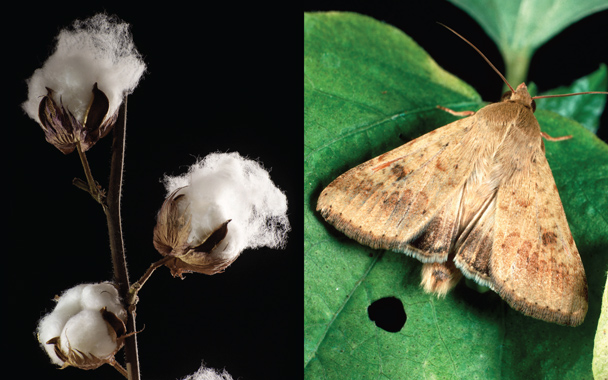Thanks to the miracles of biotechnology, cotton bollworms, a severe pest to the crop in the southeastern states, have evolved resistance to Bacillus thuringiensis (Bt), a popular organic insecticide.
In the interest of full disclosure, I should say that I’ve been known to judiciously spritz a little Bt on members of the brassica family in my own organic vegetable patch if I detect a serious enough outbreak of cabbage worms. The green caterpillars quickly succumb to the pesticide, which is produced in nature by a bacterium. It breaks down quickly and is harmless to other organisms.
But nature is one thing. Bio-engineering is another. It’s been a little over a decade since cotton seeds carrying a gene spliced from that Bt-producing bacterium left the laboratory and entered the field. Since that day, critics have been warning that massive fields of uniformly pest-resistant crops would hasten the day when bugs evolved tolerance to substances that once killed them.
That day is upon us. Writing in the February issue of the journal Nature Biotechnology, University of Arizona entomologist Bruce Tabashnik and his associates report that they found Bt-resistant bollworms in more than a dozen fields in Mississippi and Arkansas between 2003 and 2006. It is the first documented case of field-evolved resistance to a Bt crop, according to Tabashnik. Not only that, it is a dominant trait, which means that the offspring of a union of a resistant and nonresistant bollworm will inherit it, causing tolerance to spread even faster.
Insects naturally evolve resistance to pesticides, normally over decades or even centuries. With GM crops, that window has been reduced to a few years. I’m left wondering how long it will take for the cabbage worms in my garden to get the trait. Is that what they call progress?
Oysters at Bay
Great on the half shell or in a po’ boy, oysters are also among the best water filters going: a single adult can cleanse 60 gallons per day of sediment, algae, plankton, nutrients, and contaminants. Oysters used to be so numerous in Chesapeake Bay that they strained an amount of water equal to its entire contents every week. Since a population crash in the 1980s, the Chesapeake’s remaining oysters take a full year to do the same job. The formerly clear waters are laden with sediment and pollutants, a disaster not only for oysters, but for virtually every aquatic animal living there.
Last week, the Virginia Seafood Council, an industry group, asked the state’s Marine Resources Commission for permission to put 1.3 million hatchery-raised oysters in the bay beginning June 1, saying that the effort would create jobs and help clean up the murky water.
There was only one catch (a big, tasty one): The bivalves will be exotic, non-native species originally introduced to the United States from Asia. The foreign oysters not only grow bigger and faster than their American kin, but they seem to be immune to the disease that killed off the original populations. Sterilized Asian oysters (which are incapable of reproducing) have been reared in the Bay experimentally for the past several years, but this year’s crop, if approved after public hearings later this month, will be the largest yet.
That has caused concern for some scientists and environmentalists. Pointing out that the sterilization will not be 100 percent effective, they worry about the effects the alien species will have on existing stocks of oysters and other wildlife.
Meanwhile, all parties await a report on the environmental impact of Asian oysters on the Bay that is being prepared by the Army Corps of Engineers. After at least five delays, that report is now due late this year or early next. Given the Army Corps record on ecological issues, I wouldn’t hold my breath in anticipation.


